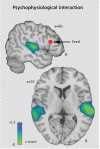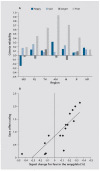Functional magnetic resonance imaging in schizophrenia
- PMID: 20954429
- PMCID: PMC3181978
- DOI: 10.31887/DCNS.2010.12.3/rgur
Functional magnetic resonance imaging in schizophrenia
Abstract
The integration of functional magnetic resonance imaging (fMRI) with cognitive and affective neuroscience paradigms enables examination of the brain systems underlying the behavioral deficits manifested in schizophrenia; there have been a remarkable increase in the number of studies that apply fMRI in neurobiological studies of this disease. This article summarizes features of fMRI methodology and highlights its application in neurobehavioral studies in schizophrenia. Such work has helped elucidate potential neural substrates of deficits in cognition and affect by providing measures of activation to neurobehavioral probes and connectivity among brain regions. Studies have demonstrated abnormalities at early stages of sensory processing that may influence downstream abnormalities in more complex evaluative processing. The methodology can help bridge integration with neuropharmacologic and genomic investigations.
L'intégration de l'IRMf (imagerie par résonance magnétique fonctionnelle) aux paradigmes de neuroscience cognitifs et affectifs permet d'examiner des circuits cérébraux qui sous-tendent les déficits comportementaux observés dans la schizophrénie ; les études neurobiologiques utilisant l'IRMf dans cette maladie sont de plus en plus nombreuses. Cet article résume les caractéristiques de la méthodologie de l'IRMf et présente ses applications dans les études neurocomportementales sur la schizophrénie. Cette technique a permis de trouver des substrats neuraux potentiels des déficits cognitifs et affectifs en fournissant des mesures d'activation aux sondes neurocomportementales et en objectivant la connectivité dans les régions cérébrales. Des études ont montré des anomalies au stade précoce du traitement de l'information sensorielle pouvant induire en aval des anomalies dans certains processus de traitement plus complexes. Cette méthodologie peut permettre de relier les résultats des investigations neuropharmacologiques et génomiques.
La integración de las imágenes de resonancia magnética funcional (IRMf) con paradigmas cognitivos y afectivos de las neurociencias permite el examen de los sistemas cerebrales que están a la base de los déficit conductuales que aparecen en la esquizofrenia. Se ha producido un notable aumento en el número de estudios que aplican las IRMf en los estudios neurobiológicos de esta enfermedad. Este artículo resume las características de la metodología de las IRMf y destaca su aplicación en los estudios neuroconductuales en la esquizofrenia. Dicho trabajo ha ayudado a dilucidar los potenciales sustratos neurales en déficit cognitivos y afectivos al proporcionar mediciones de activación para las exploraciones neuroconductuales y de conectividad entre regiones cerebrales. Los estudios han demostrado anormalidades en las etapas iniciales del procesamiento sensorial que pueden influir en una cascada de anormalidades en procesamientos de evaluatión más complejos. La metodología puede ayudar a generar puentes de integración con investigaciones neurofarmacológicas y genómicas.
Figures





Similar articles
-
Neuropsychiatric aspects of schizophrenia.CNS Neurosci Ther. 2011 Feb;17(1):45-51. doi: 10.1111/j.1755-5949.2010.00220.x. Epub 2011 Jan 2. CNS Neurosci Ther. 2011. PMID: 21199445 Free PMC article. Review.
-
The MCIC collection: a shared repository of multi-modal, multi-site brain image data from a clinical investigation of schizophrenia.Neuroinformatics. 2013 Jul;11(3):367-88. doi: 10.1007/s12021-013-9184-3. Neuroinformatics. 2013. PMID: 23760817 Free PMC article.
-
The diminished interhemispheric connectivity correlates with negative symptoms and cognitive impairment in first-episode schizophrenia.Schizophr Res. 2013 Oct;150(1):144-50. doi: 10.1016/j.schres.2013.07.018. Epub 2013 Aug 3. Schizophr Res. 2013. PMID: 23920057
-
Functional brain imaging in schizophrenia: selected results and methods.Curr Top Behav Neurosci. 2010;4:181-214. doi: 10.1007/7854_2010_54. Curr Top Behav Neurosci. 2010. PMID: 21312401 Review.
-
FMRI as a measure of cognition related brain circuitry in schizophrenia.Curr Top Behav Neurosci. 2012;11:253-67. doi: 10.1007/7854_2011_173. Curr Top Behav Neurosci. 2012. PMID: 22105156 Free PMC article. Review.
Cited by
-
The reduction of volume and fiber bundle connections in the hippocampus of EGR3 transgenic schizophrenia rats.Neuropsychiatr Dis Treat. 2015 Jul 1;11:1625-38. doi: 10.2147/NDT.S81440. eCollection 2015. Neuropsychiatr Dis Treat. 2015. PMID: 26170675 Free PMC article.
-
A Neurofunctional Domains Approach to Evaluate D1/D5 Dopamine Receptor Partial Agonism on Cognition and Motivation in Healthy Volunteers With Low Working Memory Capacity.Int J Neuropsychopharmacol. 2020 May 27;23(5):287-299. doi: 10.1093/ijnp/pyaa007. Int J Neuropsychopharmacol. 2020. PMID: 32055822 Free PMC article. Clinical Trial.
-
Increased Causal Connectivity Related to Anatomical Alterations as Potential Endophenotypes for Schizophrenia.Medicine (Baltimore). 2015 Oct;94(42):e1493. doi: 10.1097/MD.0000000000001493. Medicine (Baltimore). 2015. PMID: 26496253 Free PMC article.
-
Gene expression profiling of the dorsolateral and medial orbitofrontal cortex in schizophrenia.Transl Neurosci. 2016 Nov 27;7(1):139-150. doi: 10.1515/tnsci-2016-0021. eCollection 2016. Transl Neurosci. 2016. PMID: 28123834 Free PMC article.
-
Cognitive Effort and Schizophrenia Modulate Large-Scale Functional Brain Connectivity.Schizophr Bull. 2015 Nov;41(6):1360-9. doi: 10.1093/schbul/sbv013. Epub 2015 Mar 1. Schizophr Bull. 2015. PMID: 25731885 Free PMC article.
References
-
- Barch DM, Csernansky JG. Abnormal parietal cortex activation during working memory in schizophrenia: verbal phonological coding disturbances versus domain-general executive dysfunction. . Am J Psychiatry. 2007;164:1090–1098. - PubMed
-
- Becker TM, Kerns JG, Macdonald AW 3rd, Carter CS. Prefrontal dysfunction in first-degree relatives of schizophrenia patients during a Stroop task. . Neuropsychopharmacology. 2008;33:2619–2625. - PubMed
Publication types
MeSH terms
Substances
Grants and funding
LinkOut - more resources
Full Text Sources
Medical
